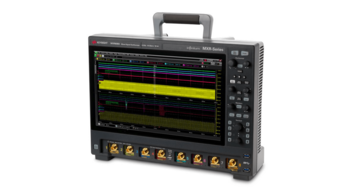- Introduction
- Main Types of Signal Generators
- Special Purpose Signal Generators
- What Is a Signal Generator Used For?
- Education
- Design
- Testing and Troubleshooting
- Equipment Calibration
- Simulation
- Buy a Keysight Signal Generator and Increase Measurement Accuracy!
- Closing Thoughts From Keysight
- Whenever You’re Ready, Here Are 4 Ways We Can Help You
Have you ever purchased something thinking you would use it for a particular application, only to discover that it had many more uses than you expected? It's like buying a Swiss Army Knife – it comes with more blades and tools than you knew existed! Signal generators are much the same way.
From audio engineering and radio-frequency design to medical testing, signal generators have become the "swiss army knife" of test equipment in many fields. These versatile machines can generate the exact electrical signal required for various products, from cell phones to automotive systems. In this article, we will explore five of the most common uses for signal generators:
- Education
- Design
- Testing and troubleshooting
- Equipment calibration
- Simulation
First, we will look at the most common types of signal generators.
Main Types of Signal Generators
Signal generators are essential in almost every laboratory, classroom, and production environment. Depending on the application, they come in many shapes, forms, and sizes.
Common types of signal generators include
- Standard signal generators. These are the most commonly available signal generators, which can generate different signals, including sine, square, triangle, and ramp. Various industries, such as telecommunications and aeronautics, use signal generators for testing, troubleshooting, and research. They also simulate radio receivers with their wide range of frequencies, making them invaluable in wireless communication device development.
- Arbitrary waveform generators. These generators produce arbitrary waveforms within specified limits. It allows you to create specific and complex signals that approximate those observed in real-life systems. AWGs also evaluate high-speed signal performance, calibrate communication systems, and help to develop modem architectures, amongst many other purposes.
- RF signal generators. These specialized signal generators generate radio frequency signals in the MHz and GHz range. They test amplifiers, research antenna patterns, and conduct reliability tests. RF signal generators are usually equipped with a wide range of frequency coverage and high accuracy capabilities, making them suitable for many applications.
- Function generators. These signal generators typically provide sine, square, triangle, and sawtooth repetitive waveforms and pulse and arbitrary waveforms. The term function generator is usually used when a generator produces a specific type of wave. The range allows users to generate signals for various types of lab equipment testing. Function generators also produce tuned signals using frequency, amplitude, offset, and other parameters.
To learn more about the basics of signal generators, check out this comprehensive buying guide. It will help you to understand the different types of signal generators available, their functions and applications, and how to choose the right one for your needs.
Special Purpose Signal Generators
While signal generators are typically versatile in their applications, some types are designed for a specific function requiring unique signals. Let's look at five of the various special-purpose signal generators
| Type | Function |
|---|---|
| Pulse generator | These generators produce pulses or triggers with a defined pulse width. Its primary function is to provide a reliable and accurate timing source. This allows vital parts of systems, such as amplifiers, communications, radars, and medical equipment, to synchronize effectively. |
| Video signal generator | This special-purpose generator produces waveforms to test and calibrate television monitors and other display systems. They generate signals in different frequencies and resolutions with one or more independent channels (monochrome or color) with adjustable parameters such as amplitude, offset, sync width, and synchronizing pulses. |
| Audio signal generator | This technical piece of equipment produces a signal typically converted into sound waves used for testing loudspeakers, microphones, headphones, and other audio equipment. In addition to testing components throughout the product development process, the device is used in fields such as acoustics and telecommunications, playing tones, or pulsed sounds to assess performance or confirm communication standards. |
| Digital pattern generator | This instrument generates repetitive multi-bit digital words. It is a versatile tool for testing digital systems such as microprocessors, interfaces, memories, and serial communication networks. Digital pattern generators are capable of data rates up to several gigabits per second, making them ideal for high-speed serial bus traffic validation and analysis tests. |
| Vector signal generator | These generators are especially useful in designing communication systems like Wi-Fi networks or telecommunication channels. They allow engineers to test projects on-site with real-time measurements before deployment. They play an essential role in making sure products are reliable and meet industry safety standards before they hit store shelves. |
What Is a Signal Generator Used For?
Now that we have looked at some main signal generator types let's explore their most common applications.
You use signal generators in fields such as
- Telecommunications. Communication engineers use signal generators to
- Test the performance of cellular systems
- Analyze signal distortion
- Measure communications protocol compliance
- Broadcasting. Broadcast engineers use them to measure
- Signal quality
- Monitor-transmitter performance
- Broadcast reliability
- Acoustics. Acoustic engineers use audio signal generators to measure the performance of
- Speakers
- Headphones
- Microphones
- Sound design. Audio engineers use them to
- Create sounds for film and music production
- Make sound effects or producing synthesized audio
- Computer engineering. Signal generators test the performance of digital circuits such as
- Microprocessors
- Memory
- Communication networks
- Medical imaging. Signal generators help test medical imaging equipment such as
- X-ray machines
- Magnetic resonance imagers (MRIs)
- Ultrasound scanners
- Radar. Radar engineers use them to
- Measure signal power
- Analyze signal-to-noise ratio
- Test the performance of radar systems
- Sonography. Sonographers use signal generators to
- Test the performance of ultrasound transducers and imaging systems to ensure they meet standards.
Signal generators also test and analyze various components within electronic devices, such as
- Amplifiers
- Microprocessors
- Memories
- Digital-to-analog converters (DACs)
- Serial communication networks
By having a better understanding of the different types and their applications, you can choose the appropriate instrument to complete various types of tasks. With that in mind, let's look at the five main uses for signal generators and what specific generators are best for each.
Education
Signal generators are invaluable in educational settings such as universities and technical colleges. They play a key role in helping students understand how signals work. Other common uses are to
- Demonstrate how to generate signals
- Demonstrate basic signal processing concepts
- Create sine, sawtooth, and square waveforms
- Simulate noise and distortion
- Analyze components such as amplifiers, filters, and oscillators.
For students learning about telecommunications, signal generators are a great way to get hands-on experience with drive levels, modulation, and phase measurements.
In terms of specific types of signal generators, any signal generator would be suitable for use in a classroom. However, function generators offer the flexibility of generating various types of waveforms. They are simple to use and are a great starting point for beginners.

Design
Design engineers use signal generators to design circuit components such as oscillators, amplifiers, and filters. They also
- Test circuit performance and analyze the effects of component variations
- Check signal integrity and system fidelity
- Measure frequency response, phase noise, and harmonic distortion
- Verify the performance and functionality of the design before fabrication.
- Debug circuit boards during the development process
Signal generators help engineers identify any issues with their design and provide valuable insight into any design problems. It provides a range of signals necessary to test a design under various conditions. This step is critical to ensure the product works as intended and meets industry safety standards before release.
A signal generator with multiple outputs is helpful for design applications, as it allows engineers to design more complex circuits. For this type of application, there are a few different signal generator types. Arbitrary waveform generators (AWGs), direct digital synthesizers (DDSs), and modulation signal generators are all suitable choices.
Arbitrary waveform generators are a common choice as they offer great flexibility and can generate a wide range of waveforms. This makes them an ideal tool for testing and simulating various signals under design applications.
Testing and Troubleshooting
A vital role signal generators play is during the testing and troubleshooting stages of production. They can
- Inspect and test components
- Perform functional tests on products
- Identify and debug issues
- Verify product specifications and performance
For this type of application, any signal generator with frequency agility is ideal as it can quickly switch between different frequency settings. This is essential when performing tests on various products with different specifications.
For troubleshooting, digital signal generators with a built-in spectrum analyzer are particularly helpful. This combination of features allows engineers to quickly identify and locate any issues with the product. Spectrum analyzers measure the frequency and power of signals, which is often useful when debugging problems.
In RF and antenna testing, signal generators measure the gain, frequency response, and other performance metrics of antennas. This is important for ensuring the antenna meets industry standards and performs as expected.
A vector signal generator is useful for antenna testing, as it generates AM, FM, and digital radio waveforms. They offer precise control over the signal parameters, allowing for accurate antenna performance testing.
Equipment Calibration
Signal generators are a go-to tool for calibrating and verifying the accuracy of test equipment. They can
- Calibrate instruments such as oscilloscopes, spectrum analyzers, and multimeters
- Perform frequency measurements
- Check the sensitivity and linearity of components
To calibrate equipment, you set the generator to a known frequency or signal level. The instrument is calibrated to that known signal to ensure it reads that value correctly. This process helps ensure the accuracy of future measurements.
Additionally, signal generators also measure frequency. By measuring the output frequency of a signal generator against a known value, you can determine the frequency accuracy of your device.
Lastly, signal generators check the sensitivity and linearity of different system components. By generating a known signal source and measuring its amplitude or power at various points along its path, you can understand how well the component performs. This information can help you decide whether or not to use that component in your design.
Signal generators with low phase noise and distortion are ideal as they provide more accurate signals for calibration. Swept-frequency and vector signal generators are excellent choices in this regard.

Simulation
Signal generators also simulate signals for model-based design applications. In particular, they can
- Generate waveforms for model verification
- Simulate real-world signals in a virtual environment
- Test control systems and algorithms
By generating signals for simulation, engineers can quickly test control systems and algorithms without having to build physical components. This allows them to test the model and algorithm before committing resources to build physical prototypes.
For example, signal generators can simulate seismic waves in seismology and geophysics. By creating a virtual environment, engineers can test how the control system responds to simulated seismic waves and refine their algorithms. The best signal generator for this application is a vector signal generator. Its low phase noise output signal makes them best suited for simulating isodynamic waves in seismic explorations.
Buy a Keysight Signal Generator and Increase Measurement Accuracy!
Regardless of the application, signal generators are versatile tools that make it possible to quickly and accurately measure, calibrate, and simulate signals. With a reliable signal generator from Keysight, you can be sure that your measurements are accurate and that your design meets industry standards and performs as expected.
We have waveform generators, swept-signal generators, vector signal generators, analog signal generators, pulse generators, and more! Get started today by browsing our selection of used signal generators. Say goodbye to inaccurate measurements and have confidence in your design. Shop now!

Closing Thoughts From Keysight
As we have seen in this article, signal generators are the champion of the test and measurement world, enabling you to quickly and accurately measure, calibrate and simulate signals. With their many uses, these digital devices are the go-to tool if you need fast and reliable results in generating test signals.
At Keysight, we provide you with the best signal generators at affordable rates for your application. With our selection of signal generators, you can be sure that your measurements are accurate and that your designs will stand out from the competition.
So don't buy a used signal generator from anyone else. Shop at Keysight and see why we are a leading supplier of signal generators for professionals. See our Used Equipment options to find our huge range of signal generators with up to 92% off!
Whenever You’re Ready, Here Are 4 Ways We Can Help You
- Browse our premium used signal generator offer
- Call tech support US: 1 800 829-4444
Press #, then 2. Hours: 7am – 5pm MT, Mon– Fri - Talk to our sales support team by clicking the icon (bottom right corner) on every offer page
- Talk to your account manager about your specific needs